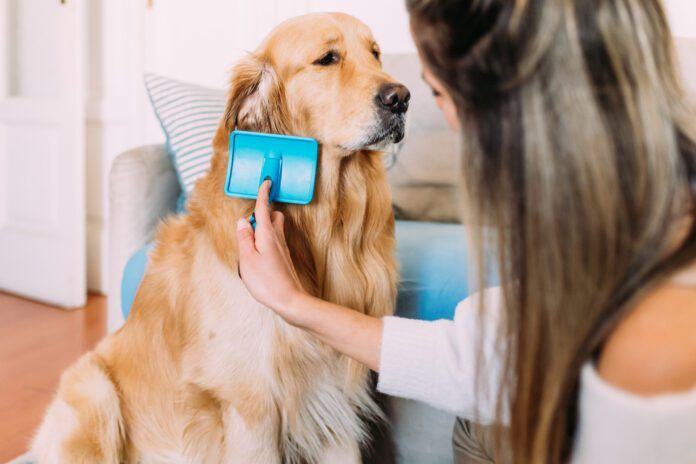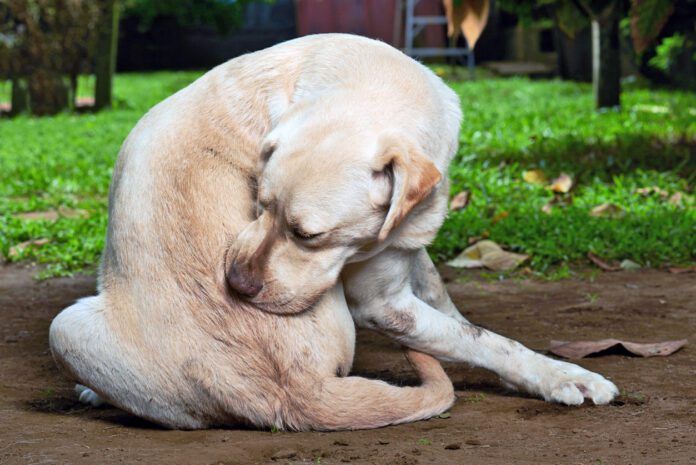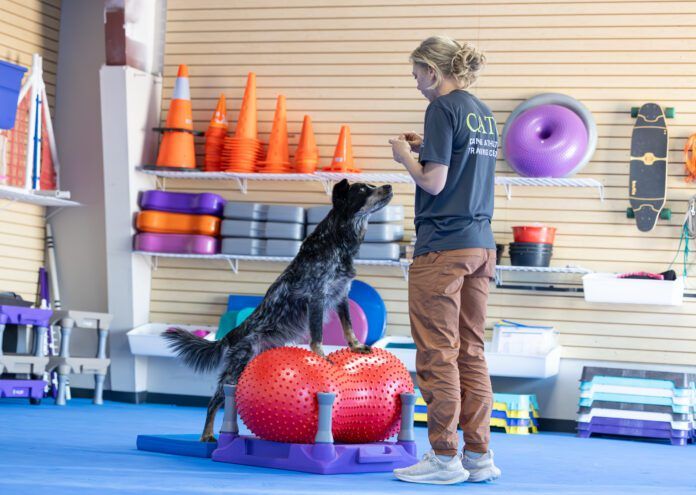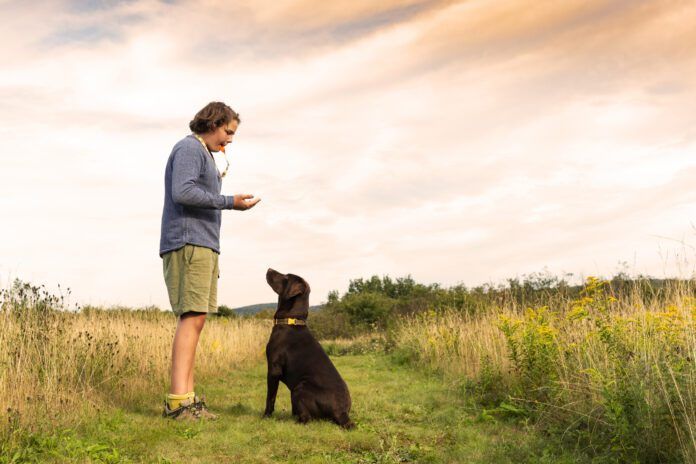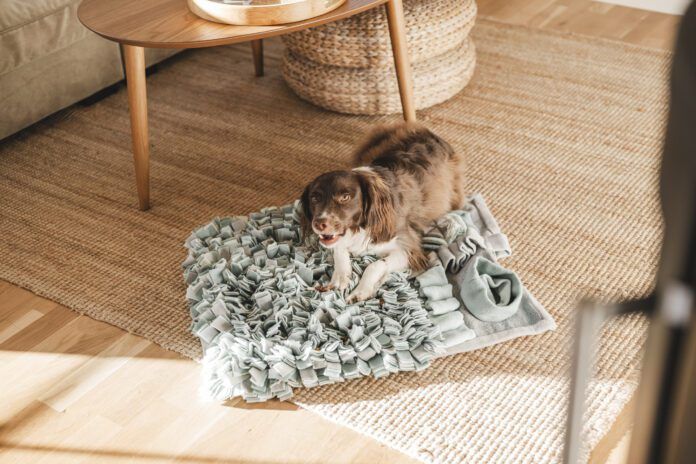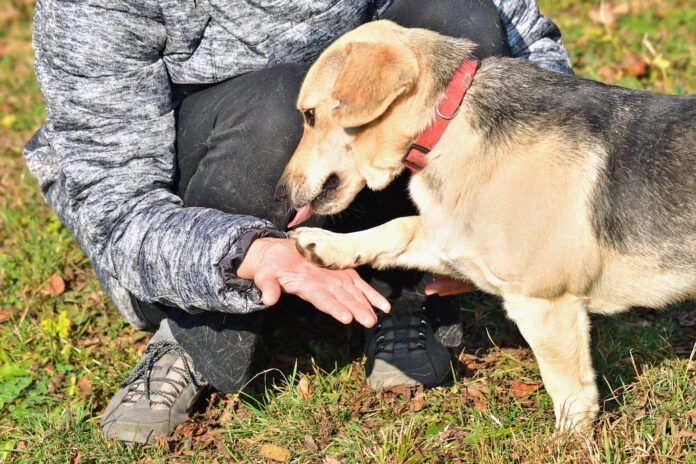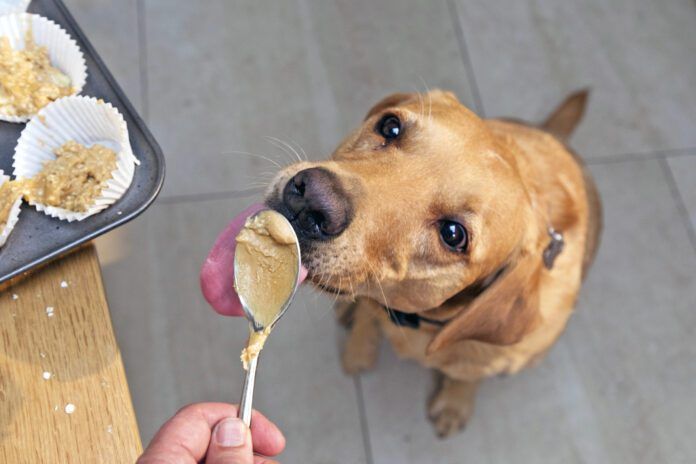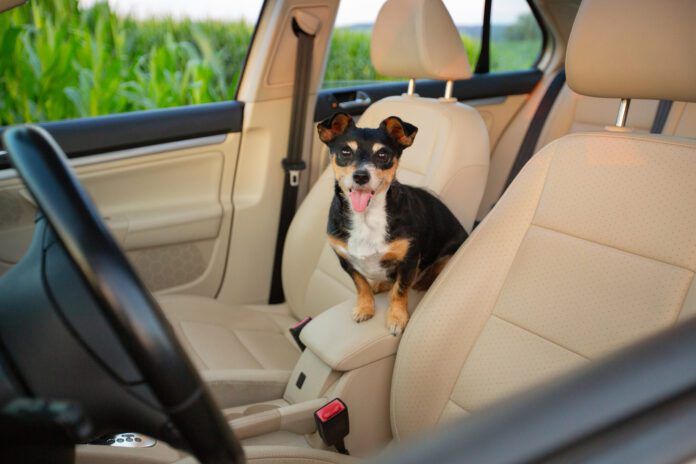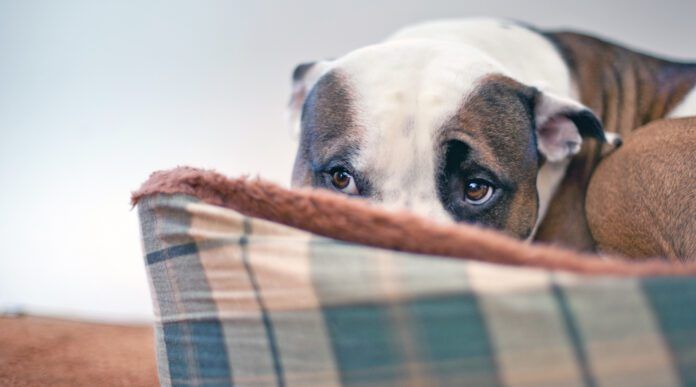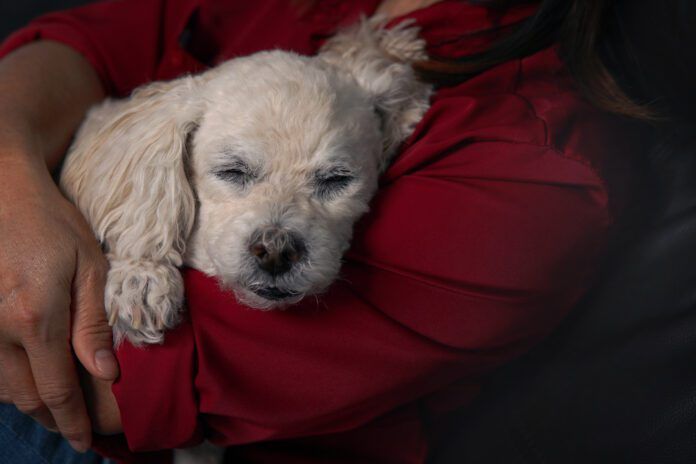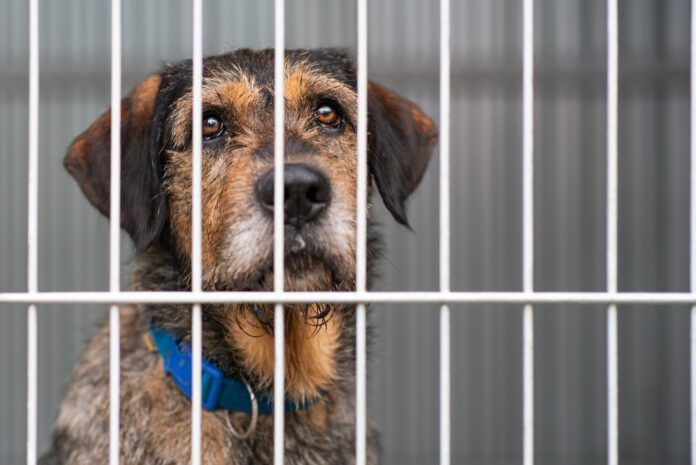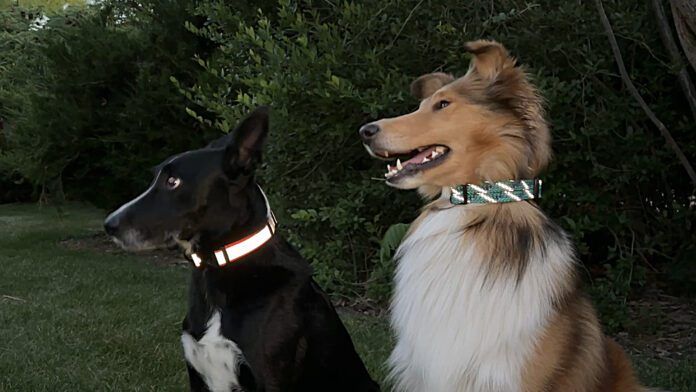If you have a medium- or long-coated dog with silky to floofy fur or a curly-coated dog like a Poodle or a Doodle, a slicker brush should be part of your grooming box. In this article, we’re going to explain what a slicker brush can do, the finer points of using a slicker brush, and how to choose the best slicker brush.
What Is a Slicker Dog Brush?
A slicker brush has a handle and a wide head, which has flexible, bendable pins of differing lengths. Slicker brushes are great for shedding. While they are designed for general grooming, good slicker brushes also remove and/or prevent mats in the coats. Slicker dog brushes are especially great for removing debris, burrs, and other plant matter that seem to grab onto these kinds of coats when the dog is out and about enjoying sniffaris.
How to Use a Dog Slicker Brush
Dog slicker brushes are used like brushes but with a lighter touch. Some are a bit firmer than others, with cause, depending on the goal. For instance, dogs with thicker coats might require a firmer brush, while a dog with softer hair will do well with a softer slicker brush. With such an abundance of sizes and styles out there from small to large, wide base to small base—even self-cleaning with some brands—we collected five slicker brushes for dogs that we think are the most popular and compared them.
How to Pick a Good Dog Slicker Brush
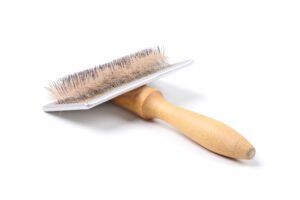
The best slicker brush depends upon your dog first and then your preferences.
Self-cleaning slicker brushes: These have a much thicker visual base than regular slickers. This may be a concern if that visual might cause some anxiety in your dog. Just be aware your dog may take longer to get used to using a self-cleaning slicker brush. Slicker brushes need to be cleaned periodically while grooming as they fill with fur. A self-cleaner basically retracts the pins and you brush away the fur. The regular brushes require you to pull the hair out, much as you do your own hairbrush.
Pin length and bends: The length and flexibility, or softness, of the pins will concern your dog. A thick-coated dog like a Collie, Sheltie, or Australian Shepherd will require longer pins to get deeper into the coat. A Papillon, a long-haired, single-coated, breed requires softer flexible pins.
Types and shapes of handles: These matter for the human’s comfort when using the brush. A slimmer ergonomic handle is usually the most comfortable option, but your hand size will determine comfort for you. Most slicker brush handles have a rubbery, comfortable feel.
How We Selected Our Favorite Slicker Brush
We chose what we determined to be the five most popular slicker brushes available, based on recommendations from dog competitors, dog trainers, and regular dog parents.
We then compared each brush’s ease of use as well as how heavy each felt in our hand. We evaluated how comfortable each was to hold while in use.
The visual of the brush head with how the dog would see it was an important factor for us. A larger visual can mean a more anxious dog, depending on that dog’s level of anxiety with this process.
And, of course, of primary importance was how comfortable the dog felt when being brushed with each brush, using a solid knowledge of dog body language to determine how the dogs reacted to each brush.
Finally, we compared the ease of cleaning of each brush.
The Best Slicker Brushes for Dogs
| Rating | Product and Manufacturer | Price | Notes |
|---|---|---|---|
    | Chris Christianson Big K Slicker Brush | $59.90 | Well-designed, comfortable for dog and handler, and did a great job. A top-quality brush, although the price may give you pause. Our top choice. |
   | Hertzko Flexible Slicker Brush | $12.99 | This brush isn’t perfect. We’d like a more comfortable handle, but our dogs liked it and you’re getting a lot for the money here. Our best buy choice. |
   | Swithawk Self Cleaning Slicker Brush | $19.98 | A bit heavy and maybe too large for smaller hands, but the handle felt soft. It has a self-cleaning feature that we loved, and it gives you color choices. It’s worth considering. |
   | iToleeve Dog Brush & Slicker Brush | $20.99 | This brush comes with a flea/tick comb. It felt light in our hands, especially for a dual-sided brush. The pins were bendable, and it cleaned nicely. But both our dogs and us preferred other brushes. |
  | Coastal Pet Safari Curved Firm Slicker Brush | $10.49 | The least expensive brush in our comparison and advertised as firm. Too firm for us, unfortunately. |
Here’s what we found:
Best Overall Dog Slicker Brush: Chris Christianson Big K slicker brush:
4 Paws
The Chris Christianson slicker brush was a dream to use, pulling out those tiny clinging burrs that fall weather in the Northeast brings in abundance, and leaving the coat looking great.
The Big K was a dream for dense long-haired coats. We found it to be the best dog brush for shedding and debris removal for this type of coated dog. It very gently but thoroughly pulls out the undercoat with barely any pressure on the dog in question.
The handle is comfortable and ergonomically designed. It’s one of the more expensive slicker brushes on the market, but it’s worth the price. Retails for $59.50. Our top choice.
Chris Christianson Big K Slicker Brush
Best Budget Dog Slicker Brush: Hertzko Flexible Slicker Brush
3 1/2 paws
This brush has a wide brush head that we liked. It’s a little heavier than most other slicker brushes, probably due to its metal backing to the brush head. We found the pins area was a bit longer and better curved than the self-cleaning brush options. The handle is comfortable but not as ergonomically designed as the Chris Christianson. One dog who was not a big fan of slicker brushes in general, retreated from all the brushes except this one and the Chris Christenson. That said, most dogs can be conditioned to tolerate and even enjoy being brushed with an appropriate brush at the most appropriate pressure for that dog.
This brush was a bit more difficult to clean than the others in this comparison, probably due to the wider brush base, but it was really no more than most slicker brushes that didn’t make the initial cut. At $12.99, it’s a great deal for both price and function, and we’re going to call it our best buy.
Hertzko Flexible Slicker Brush
Best Self Cleaning Dog Slicker Brush: Swihawk Self Cleaning Slicker Brush:
3 paws
The Swihawk brush has a larger presence than many slicker dog brushes due to the self-cleaning feature. That means that the end piece that has the enclosed brush in it is thicker than those that are not self-cleaning. Because of that larger presence and the self-cleaning feature, it is also heavier than most, even the Hertzko one with the metal base for the pins. It also has a thicker handle, which may not be ideal for smaller-handed groomers. However, it is curved and feels soft in the hand.
The self-cleaning feature is superb and oh so easy to use. You can remove all the fur that you just brushed out pretty much in an instant with this brush. The pins in this brush are shorter than others in the comparison and less curved, which may be issue for some dogs, especially if your dog’s fur is longer than the pins! For a shorter or perhaps silkier-coated, this would work great. Overall, the self-cleaning option is very attractive. It also comes I color choices, if that matters to you. Priced at $19.98, this brush is worth considering.
Swihawk Self Cleaning Slicker Brush
Best Slicker Brush for Dense Coats: iToleeve Dog Brush & Slicker Brush
3 paws
This is a dual-headed and dual-sided brush. One side has straight pins, and the other side has curved pins of a nice length. It’s promoted as being a gentler option for more sensitive dogs, but our test dogs didn’t seem to agree. It seemed to pull on the fur a bit more than the other options, aside from the Safari. The brush does not have a large presence, the handle is quite comfortable and grippy, and the brush feels very light. It is very flexible and does seem to bend into the brushing again as advertised. It was easy to clean probably because of that dual head on each side. For denser coats, like German Shepherds have, it seemed to work great. It comes with a coordinating flea and tick comb for $20.99.
iToleeve Dog Brush & Slicker Brush
We Also Tested: Coastal Pet Safari Curved Firm Slicker Brush
2 paws
As the name indicates, this brush is firm. It has a small presence with its compact head. The handle was comfortable, albeit a bit shorter than the others. The pins are reasonable long and perfectly curved. The instructions for use for each type of dog coat that this brush may work for are very detailed, which is super helpful. The manufacturer does suggest using a light touch with longer flowing coats. We agree. This brush is the least expensive choice, retailing for $10.49, but we shy away from it due to its firm pins.
Coastal Pet Safari Curved Firm Slicker Brush
The most important take away here is to make sure that you read the details on which type of coat that each slicker dog brush is meant to be used for and what they do best. This will help you choose the right one for your own dog and help you maintain that glossy coat we all love. And if you’ve never used one on your dog before, take it slow and let the dog get used to the feel of the slicker brush. Happy grooming!


